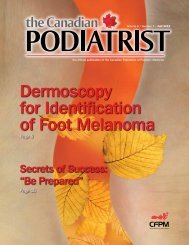Disinfection and Sterilization in the Chiropody Office
Disinfection and Sterilization in the Chiropody Office
Disinfection and Sterilization in the Chiropody Office
Create successful ePaper yourself
Turn your PDF publications into a flip-book with our unique Google optimized e-Paper software.
1<br />
<strong>Dis<strong>in</strong>fection</strong> <strong>and</strong> <strong>Sterilization</strong> <strong>in</strong> <strong>the</strong> <strong>Chiropody</strong> <strong>Office</strong><br />
Def<strong>in</strong>ition of Terms<br />
Antiseptic: are germicides applied to liv<strong>in</strong>g tissue <strong>and</strong> sk<strong>in</strong>. Commonly used antiseptics<br />
for sk<strong>in</strong> clean<strong>in</strong>g <strong>in</strong>clude benzalkonium chloride, chlorhexid<strong>in</strong>e, hexachloroph<strong>in</strong>e, iod<strong>in</strong>e<br />
compounds, 70% alcohol <strong>and</strong> 3%hydrogen peroxide.<br />
Clean<strong>in</strong>g: manual removal of visible soil from objects, <strong>and</strong> surfaces, before plac<strong>in</strong>g<br />
<strong>in</strong>struments <strong>in</strong>to ultrasonic solution (mechanical).<br />
Contam<strong>in</strong>ated: soiled with disease-produc<strong>in</strong>g microorganisms.<br />
Dis<strong>in</strong>fectants: are antimicrobials applies only to <strong>in</strong>animate objects.<br />
In general, antiseptics are used only on <strong>the</strong> sk<strong>in</strong> <strong>and</strong> not for surface dis<strong>in</strong>fection, <strong>and</strong><br />
dis<strong>in</strong>fectants are not used for sk<strong>in</strong> antisepsis because <strong>the</strong>y can <strong>in</strong>jure sk<strong>in</strong> <strong>and</strong> o<strong>the</strong>r tissues.<br />
<br />
<br />
<br />
<strong>Dis<strong>in</strong>fection</strong>: process that kills most disease produc<strong>in</strong>g microorganisms but rarely kills all<br />
spores. Used on <strong>in</strong>animate objects (treatment chair, operator light, h<strong>and</strong>piece or nail<br />
drill, etc).<br />
o Low Level <strong>Dis<strong>in</strong>fection</strong>: required when process<strong>in</strong>g non-critical<br />
equipment/devices (Treatment chair, operator’s stool, operator’s light)<br />
o High Level <strong>Dis<strong>in</strong>fection</strong>: required when process<strong>in</strong>g semi-critical<br />
equipment/devices (CPR/respiratory equipment, ultrasound/laser)<br />
Germicide: is an agent that can kill microorganisms, particularly pathogenic organisms<br />
(“germs”). The term germicide <strong>in</strong>cludes both antiseptics <strong>and</strong> dis<strong>in</strong>fectants.<br />
<strong>Sterilization</strong>: process by which ALL microorganisms are killed, <strong>in</strong>clud<strong>in</strong>g bacteria, viruses,<br />
spores <strong>and</strong> fungi.<br />
Approach to <strong>Dis<strong>in</strong>fection</strong> & <strong>Sterilization</strong><br />
Critical Items: are high rick for <strong>in</strong>fection if <strong>the</strong>y are contam<strong>in</strong>ated with any<br />
microorganism. Objects that have <strong>the</strong> possibility of enter<strong>in</strong>g tissue must be sterile<br />
because any microbial contam<strong>in</strong>ation could transmit disease. These objects must be<br />
sterilized with an autoclave. All h<strong>and</strong> <strong>in</strong>struments, surgical <strong>in</strong>struments are a few<br />
examples.<br />
Semi-Critical Items: contact mucous membranes or non<strong>in</strong>tact sk<strong>in</strong>. High-level<br />
dis<strong>in</strong>fection traditionally is def<strong>in</strong>ed as complete elim<strong>in</strong>ation of all microorganisms <strong>in</strong> or<br />
on an <strong>in</strong>strument, except for small numbers of bacterial spores. Clean<strong>in</strong>g followed by<br />
high-level dis<strong>in</strong>fection should elim<strong>in</strong>ate enough pathogens to prevent transmission of<br />
<strong>in</strong>fection. Devices such as CPR masks, Nitrous oxide mask, Ultrasound/laser h<strong>and</strong> held<br />
devices, nail drill h<strong>and</strong>peices are a few examples.<br />
Non-Critical Items: are those items that come <strong>in</strong> contact with <strong>in</strong>tact sk<strong>in</strong> but not mucous<br />
membranes. Intact sk<strong>in</strong> acts as an effective barrier to most microorganisms. Examples<br />
of non-critical patient-care items are computers (keyboard & mouse), paper charts or<br />
items from <strong>the</strong> treatment room, patient furniture, treatment room floors.
2<br />
<strong>Dis<strong>in</strong>fection</strong> of <strong>the</strong> Healthcare Equipment<br />
There are many dis<strong>in</strong>fection of environmental surfaces <strong>in</strong> health-care facilities readily available<br />
through our medical suppliers. Many of <strong>the</strong>se dis<strong>in</strong>fectants have a contact time of 30-60<br />
seconds which have significant microbial reduction. Consult your medical supplier for a<br />
registered or government approved product <strong>and</strong> confirm <strong>the</strong> usage, storage <strong>and</strong> shelf life of<br />
<strong>the</strong>se products.<br />
Factors affect<strong>in</strong>g <strong>the</strong> Efficacy of <strong>Dis<strong>in</strong>fection</strong> & <strong>Sterilization</strong><br />
Physical location & Cross contam<strong>in</strong>ation (efficient <strong>in</strong>strument process<strong>in</strong>g, separate<br />
clean<strong>in</strong>g, sterilization <strong>and</strong> storage. Workflow direction elim<strong>in</strong>ates <strong>the</strong> risk of crosscontam<strong>in</strong>ation)<br />
Duration of exposure (appropriate m<strong>in</strong>imum contact time)<br />
Concentration of Dis<strong>in</strong>fectants (solutions improperly measured/mixed)<br />
Physical & Chemical Factors (temperature, water hardness, relative humidity, PH)<br />
Organic & Inorganic Matter (where all <strong>the</strong> <strong>in</strong>struments properly<br />
manually/mechanically cleaned)<br />
<strong>Dis<strong>in</strong>fection</strong> & <strong>Sterilization</strong><br />
1. Pre-clean<strong>in</strong>g<br />
Immediately after use, r<strong>in</strong>se <strong>in</strong>struments under warm runn<strong>in</strong>g water. R<strong>in</strong>s<strong>in</strong>g should remove<br />
most of <strong>the</strong> blood, body fluids <strong>and</strong> tissue.<br />
2. Clean<strong>in</strong>g<br />
Spray a non aerosol, dual enzyme foam to loosen <strong>and</strong> breakdown any rema<strong>in</strong><strong>in</strong>g blood <strong>and</strong><br />
debris.<br />
A. Manual Clean<strong>in</strong>g (prior to ultrasonic clean<strong>in</strong>g)<br />
I. Put on mask, eye protection <strong>and</strong> gloves (puncture proof utility gloves as an over-glove may be<br />
added) Personal protective equipment should be worn when scrubb<strong>in</strong>g <strong>in</strong>struments.<br />
Instruments should also be submerged under water when be<strong>in</strong>g cleaned to m<strong>in</strong>imize aerosols.<br />
II. Use a stiff plastic nylon clean<strong>in</strong>g brush. Do not use steel wool or wire brushes as <strong>the</strong>y may<br />
damage <strong>the</strong> <strong>in</strong>struments.<br />
III. Use neutral pH (7) cleaners. Lower of higher pH detergents cause surface sta<strong>in</strong><strong>in</strong>g of brown<br />
<strong>and</strong> black deposits which <strong>in</strong>terfere with <strong>the</strong> smooth operation of <strong>the</strong> <strong>in</strong>strument by break<strong>in</strong>g<br />
down <strong>the</strong> sta<strong>in</strong>less protective surface.<br />
IV. Brush <strong>in</strong>struments carefully <strong>and</strong> h<strong>and</strong>les <strong>the</strong>m totally separate from general <strong>in</strong>struments.<br />
V. Make sure all <strong>in</strong>strument surfaces are visibly clean <strong>and</strong> free from sta<strong>in</strong>s <strong>and</strong> tissue. While<br />
r<strong>in</strong>s<strong>in</strong>g, open <strong>and</strong> close scissors, hemostats <strong>and</strong> o<strong>the</strong>r h<strong>in</strong>ged <strong>in</strong>struments to make sure <strong>the</strong><br />
h<strong>in</strong>ge areas are r<strong>in</strong>sed out, as well as <strong>the</strong> surface of <strong>the</strong> <strong>in</strong>struments.<br />
B. Ultrasonic Clean<strong>in</strong>g<br />
Instruments should be processed <strong>in</strong> <strong>the</strong> cleaner for <strong>the</strong> full recommended cycle time – usually 5<br />
to 10 m<strong>in</strong>utes. Use a multipurpose concentrated <strong>in</strong>strument cleaner (Metriclean 2). Place<br />
<strong>in</strong>struments <strong>in</strong> open position <strong>in</strong>to <strong>the</strong> ultrasonic cleaner. Make sure that “Sharps” (scissors,<br />
knives, etc.) blades do not touch o<strong>the</strong>r <strong>in</strong>struments. All <strong>in</strong>struments must be fully submerged.<br />
Do not place differ<strong>in</strong>g metals (sta<strong>in</strong>less, copper, chrome-plated, etc.) <strong>in</strong> <strong>the</strong> same clean<strong>in</strong>g cycle.
3<br />
Change solution frequently – daily. R<strong>in</strong>se <strong>the</strong> <strong>in</strong>struments with water after ultrasonic clean<strong>in</strong>g to<br />
remove solution.<br />
3. After Clean<strong>in</strong>g<br />
Any <strong>in</strong>struments with h<strong>in</strong>ges/screws/movable parts should be selected <strong>and</strong> placed <strong>in</strong> an<br />
Instrument Lubricant Milk Bath (usually for 5 m<strong>in</strong>utes), <strong>and</strong> <strong>the</strong>n r<strong>in</strong>sed <strong>in</strong> warm water.<br />
4. Before Autoclav<strong>in</strong>g<br />
1. Inspect <strong>in</strong>struments for any blood or debris.<br />
2. Make sure <strong>in</strong>struments are completely dry.<br />
3. Use <strong>the</strong> appropriate steriliz<strong>in</strong>g pouch size for <strong>in</strong>struments<br />
4. Place <strong>in</strong>strument guards when needed to prevent punctur<strong>in</strong>g pouches<br />
5. Seal Pouch.<br />
6. For grouped surgical sets <strong>in</strong>sert a sterile <strong>in</strong>dicator strip. Place autoclave tape on<br />
outside of <strong>the</strong> wrapped <strong>in</strong>strument tray.<br />
7. Transfer trays to central steriliz<strong>in</strong>g services.<br />
5. Autoclav<strong>in</strong>g<br />
Individual Instruments:<br />
Disposable pouches are ideal. Make sure you use a wide enough pouch for <strong>in</strong>struments with<br />
ratchet locks such as nippers <strong>and</strong> hemostats so <strong>the</strong> <strong>in</strong>strument can be sterilized <strong>in</strong> an open<br />
(unlocked) position.<br />
Instrument Sets:<br />
Unlock all <strong>in</strong>struments <strong>and</strong> sterilize <strong>the</strong>n <strong>in</strong> an open position. Place heavy <strong>in</strong>struments on<br />
bottom of set (when 2 layers are required). Place <strong>in</strong> a sterilizable tray <strong>and</strong> wrap entire tray with<br />
sterilization wrap<br />
Rationale<br />
Never lock an <strong>in</strong>strument dur<strong>in</strong>g autoclav<strong>in</strong>g. It will not be sterile as steam cannot reach <strong>the</strong><br />
metal to metal surfaces. The <strong>in</strong>strument will develop cracks <strong>in</strong> h<strong>in</strong>ge areas because of heat<br />
expansion dur<strong>in</strong>g <strong>the</strong> autoclave cycle.<br />
Sample Performance Indictors & Record Keep<strong>in</strong>g<br />
Please feel free to pr<strong>in</strong>t any of <strong>the</strong> below <strong>in</strong>formation <strong>and</strong> customize <strong>the</strong> details for your office<br />
<strong>and</strong> your br<strong>and</strong> of sterilizer. The below is a sample from a chiropody cl<strong>in</strong>ic to illustrate <strong>the</strong><br />
details required. You should also review from The College of Chiropodist Of Ontario’s website,<br />
under <strong>the</strong> head<strong>in</strong>g Infection Control gives <strong>the</strong> details of <strong>the</strong> m<strong>in</strong>imal requirements.<br />
COCOO St<strong>and</strong>ards of Infection Control<br />
1. Member shall endeavor to prevent <strong>the</strong> transmission of microorganisms from<br />
patient to patient, patient to member <strong>and</strong> member to patient.
4<br />
Autoclave Sterilizer<br />
Clean<strong>in</strong>g <strong>and</strong> Test<strong>in</strong>g Policy <strong>and</strong> Procedure<br />
Policy<br />
In order to ma<strong>in</strong>ta<strong>in</strong> high st<strong>and</strong>ards of dis<strong>in</strong>fection <strong>and</strong> comply<strong>in</strong>g with <strong>the</strong> M<strong>in</strong>istry of Health<br />
<strong>and</strong> <strong>the</strong> College of Chiropodist <strong>the</strong> equipment used to sterilize <strong>in</strong>struments is to be serviced<br />
yearly. The equipment used to sterilize <strong>in</strong>struments is to be cleaned <strong>and</strong> tested monthly for<br />
accuracy of kill<strong>in</strong>g spores. A record is to be ma<strong>in</strong>ta<strong>in</strong>ed regard<strong>in</strong>g <strong>the</strong> PASS status certificate. This<br />
is scheduled for <strong>the</strong> first Tuesday of each month.<br />
Procedure<br />
We have two autoclaves which have been marked as Sterilizer #1 <strong>and</strong> Sterilizer #2.<br />
They both have to be serviced yearly for <strong>in</strong>spection.<br />
They both have to be cleaned <strong>and</strong> tested each month.<br />
The product used to clean <strong>the</strong> autoclave prior to test<strong>in</strong>g is alternated from month to month.<br />
Sterilizer #1 is (Make & Model)<br />
Sterilizer #2 is (Make & Model)<br />
Yearly Servic<strong>in</strong>g <strong>and</strong> Inspection of Autoclaves<br />
Please Call <strong>in</strong> June of each year: J.A. Walker Bio-Med Services, Joe Walker Tel 519-319-2423 to<br />
have both sterilizers serviced <strong>and</strong> <strong>in</strong>spected for yearly ma<strong>in</strong>tenance. He will schedule a day/time<br />
<strong>and</strong> <strong>the</strong>n will provide a Certificate for each sterilizer to be placed <strong>in</strong> each pouch for each<br />
sterilizer.<br />
Chamber Brite<br />
January, March, May, July, September <strong>and</strong> November: Chamber Brite is to be used.<br />
This product is purchase at (your supplier <strong>in</strong>fo) Description of Chamber Brite Autoclave Cleaner<br />
1 box of 10 sachets.<br />
Speed-Clean<br />
February, April, June, August, October, <strong>and</strong> December: Speed-Clean is to be used.<br />
This product is purchased at (your supplier <strong>in</strong>fo)<br />
B-Safe Germiphene Corporation<br />
One yearly kit B-Safe Biological Spore Test<strong>in</strong>g Analysis is purchase from Germephene<br />
Corporation by call<strong>in</strong>g 1-800-265-9931. Our customer number is# ______ Cl<strong>in</strong> for order<strong>in</strong>g but<br />
our customer ID is ____<br />
Due to <strong>the</strong> fact we test both autoclaves this provides us with only 6 months of test<strong>in</strong>g.<br />
Therefore one kit is ordered every 6 months. We do not want two kits <strong>in</strong> stock because of <strong>the</strong><br />
short expiry date of <strong>the</strong> kit as well as <strong>the</strong> expensive cost of <strong>the</strong> kit $215.<br />
View Onl<strong>in</strong>e B-Safe Record go to www.germiphene.com click on B-SAFE <strong>in</strong> <strong>the</strong> B-SAFE Result<br />
Search area enter <strong>the</strong> User ID <strong>and</strong> Password<br />
The User ID is Customer ID: _______<br />
The Password is our phone number: ______
5<br />
Instructions for Chamber Brite Autoclave Clean<strong>in</strong>g Procedure<br />
For both Sterilizer #1 <strong>and</strong> Sterilizer #2<br />
January, March, May, July, September <strong>and</strong> November<br />
Chamber Brite is a clean<strong>in</strong>g <strong>and</strong> descal<strong>in</strong>g agent designed specifically for <strong>the</strong> clean<strong>in</strong>g <strong>and</strong><br />
removal of water deposit oxides <strong>and</strong> o<strong>the</strong>r sediment that are found <strong>in</strong> steam sterilizers.<br />
1. when autoclave chamber is cold, remove <strong>in</strong>struments <strong>and</strong> trays from <strong>the</strong> autoclave<br />
2. open <strong>the</strong> door <strong>and</strong> spread <strong>the</strong> contents of <strong>the</strong> Chamber Brite packet <strong>in</strong> a straight even<br />
l<strong>in</strong>e along <strong>the</strong> bottom of <strong>the</strong> chamber, from back to <strong>the</strong> front<br />
3. start a sterilization cycle with water as you would usually ( 30 m<strong>in</strong>)<br />
4. when <strong>the</strong> cycle ends right away exhaust <strong>the</strong> steam <strong>and</strong> <strong>the</strong>n dra<strong>in</strong> all <strong>the</strong> water from <strong>the</strong><br />
reservoir by remov<strong>in</strong>g <strong>the</strong> plug at <strong>the</strong> bottom of <strong>the</strong> autoclave over <strong>the</strong> s<strong>in</strong>k<br />
5. fill <strong>the</strong> water reservoir with distilled water to <strong>the</strong> full l<strong>in</strong>e<br />
6. repeat a sterilization cycle with water but this time without Chamber Brite powder (30<br />
m<strong>in</strong>)<br />
7. when <strong>the</strong> cycle ends right away exhaust <strong>the</strong> steam <strong>and</strong> <strong>the</strong>n dra<strong>in</strong> all <strong>the</strong> water from <strong>the</strong><br />
reservoir by remov<strong>in</strong>g <strong>the</strong> plug at <strong>the</strong> bottom of <strong>the</strong> autoclave over <strong>the</strong> s<strong>in</strong>k<br />
8. turn <strong>the</strong> autoclave off <strong>and</strong> allow chamber to cool<br />
9. remove <strong>the</strong> tray holder, wipe <strong>the</strong> <strong>in</strong>terior of <strong>the</strong> chamber with a damp cloth while be<strong>in</strong>g<br />
careful not to damage <strong>the</strong> heater element or <strong>the</strong> temperature <strong>and</strong> level sensors<br />
10. re<strong>in</strong>stall <strong>the</strong> trays <strong>in</strong> <strong>the</strong> chamber while mak<strong>in</strong>g sure <strong>the</strong> tray rack is to <strong>the</strong> back of <strong>the</strong><br />
chamber<br />
11. fill <strong>the</strong> water reservoir with distilled water to <strong>the</strong> full l<strong>in</strong>e<br />
12. <strong>the</strong> autoclave is ready for <strong>the</strong> B-Safe Test<strong>in</strong>g Spores<br />
13. LOG your task as be<strong>in</strong>g accomplished by complet<strong>in</strong>g, dat<strong>in</strong>g <strong>and</strong> sign<strong>in</strong>g <strong>the</strong><br />
Autoclave Test<strong>in</strong>g Log Sheet<br />
Instructions for Speed Clean Autoclave Clean<strong>in</strong>g Procedure<br />
For both Sterilizer #1 <strong>and</strong> Sterilizer #2<br />
February, April, June, August, October, <strong>and</strong> December<br />
Speed-Clean is a slightly alkal<strong>in</strong>e, multi-purpose solution used to remove grease <strong>and</strong> grime from<br />
sterilizer. It will also retard scale deposits.<br />
1. dra<strong>in</strong> <strong>and</strong> refill <strong>the</strong> reservoir with clean distilled water<br />
2. add one ounce of Speed-Clean to a cool chamber<br />
3. start a sterilization cycle with water as you would usually (30 m<strong>in</strong>)<br />
4. when <strong>the</strong> cycle ends right away exhaust <strong>the</strong> steam <strong>and</strong> <strong>the</strong>n dra<strong>in</strong> all <strong>the</strong> water from <strong>the</strong><br />
reservoir by remov<strong>in</strong>g <strong>the</strong> plug at <strong>the</strong> bottom of <strong>the</strong> autoclave over <strong>the</strong> s<strong>in</strong>k<br />
5. fill <strong>the</strong> water reservoir with distilled water to <strong>the</strong> full l<strong>in</strong>e<br />
6. repeat a sterilization cycle with water but this time without Speed-Clean (30 m<strong>in</strong>)<br />
7. when <strong>the</strong> cycle ends right away exhaust <strong>the</strong> steam <strong>and</strong> <strong>the</strong>n dra<strong>in</strong> all <strong>the</strong> water from <strong>the</strong><br />
reservoir by remov<strong>in</strong>g <strong>the</strong> plug at <strong>the</strong> bottom of <strong>the</strong> autoclave over <strong>the</strong> s<strong>in</strong>k<br />
8. turn <strong>the</strong> autoclave off <strong>and</strong> allow chamber to cool
6<br />
9. remove <strong>the</strong> tray holder, wipe <strong>the</strong> <strong>in</strong>terior of <strong>the</strong> chamber with a damp cloth while be<strong>in</strong>g<br />
careful not to damage <strong>the</strong> heater element or <strong>the</strong> temperature <strong>and</strong> level sensors<br />
10. re<strong>in</strong>stall <strong>the</strong> trays <strong>in</strong> <strong>the</strong> chamber while mak<strong>in</strong>g sure <strong>the</strong> tray rack is to <strong>the</strong> back of <strong>the</strong><br />
chamber<br />
11. fill <strong>the</strong> water reservoir with distilled water to <strong>the</strong> full l<strong>in</strong>e<br />
12. <strong>the</strong> autoclave is ready for <strong>the</strong> B-Safe Test<strong>in</strong>g Spores<br />
13. LOG your task as be<strong>in</strong>g accomplished by complet<strong>in</strong>g, dat<strong>in</strong>g <strong>and</strong> sign<strong>in</strong>g<br />
<strong>the</strong> Autoclave Test<strong>in</strong>g Log Sheet<br />
B-SAFE Test<strong>in</strong>g Procedure<br />
B-Safe Kit conta<strong>in</strong>s envelopes each with <strong>the</strong> Form <strong>and</strong> <strong>the</strong> Test Spore Strips. When only 2 left<br />
you need to order a new kit.<br />
Take one envelope for each sterilizer to be tested.<br />
Read <strong>the</strong> Biological Spore-test Direction for Use<br />
DO NOT remover <strong>the</strong> Test <strong>and</strong> Control Strips from <strong>the</strong> Blue Packag<strong>in</strong>g<br />
1. place <strong>the</strong> two strips labeled Biological <strong>in</strong>dicator TEST strips <strong>in</strong> <strong>the</strong> sterilizer along with a<br />
normal load.<br />
2. <strong>the</strong>se two strips should be placed <strong>in</strong> <strong>the</strong> most difficult to sterilize location, such as <strong>the</strong><br />
front <strong>and</strong> <strong>the</strong> middle-back of <strong>the</strong> autoclave.<br />
3. do not overload <strong>the</strong> sterilizer<br />
4. run a 30 m<strong>in</strong> cycle<br />
5. <strong>the</strong> third strip Biological <strong>in</strong>dicator CONTROL strip is NOT put <strong>in</strong> <strong>the</strong> autoclave<br />
6. Once <strong>the</strong> sterilization of <strong>the</strong> two TEST strips is complete place all three: 2 TEST <strong>and</strong> 1<br />
CONTROL with <strong>the</strong> completed <strong>Sterilization</strong> Monitor<strong>in</strong>g Service Report Forms <strong>in</strong>to <strong>the</strong> self<br />
addressed envelope <strong>and</strong> mail to Germiph<strong>in</strong>e Corporation.<br />
7. <strong>the</strong> strips will be tested <strong>and</strong> report sent back to us<br />
8. once we receive <strong>the</strong> report <strong>the</strong>n apply <strong>the</strong> PASS sticker on <strong>the</strong> appropriate certificate for<br />
each sterilizer pouch.<br />
9. LOG your task as be<strong>in</strong>g accomplished by complet<strong>in</strong>g, dat<strong>in</strong>g <strong>and</strong> sign<strong>in</strong>g<br />
<strong>the</strong> Autoclave Test<strong>in</strong>g Log Sheet<br />
In <strong>the</strong> envelope fill out <strong>the</strong> form accord<strong>in</strong>gly to <strong>the</strong> blank example provided.<br />
After a few weeks of send<strong>in</strong>g <strong>the</strong> envelope we will receive a report from Germiphene. Put <strong>the</strong><br />
green PASS sticker on each sterilizer certificate <strong>and</strong> keep <strong>the</strong> letter of confirmation <strong>in</strong> <strong>the</strong> pouch.
















